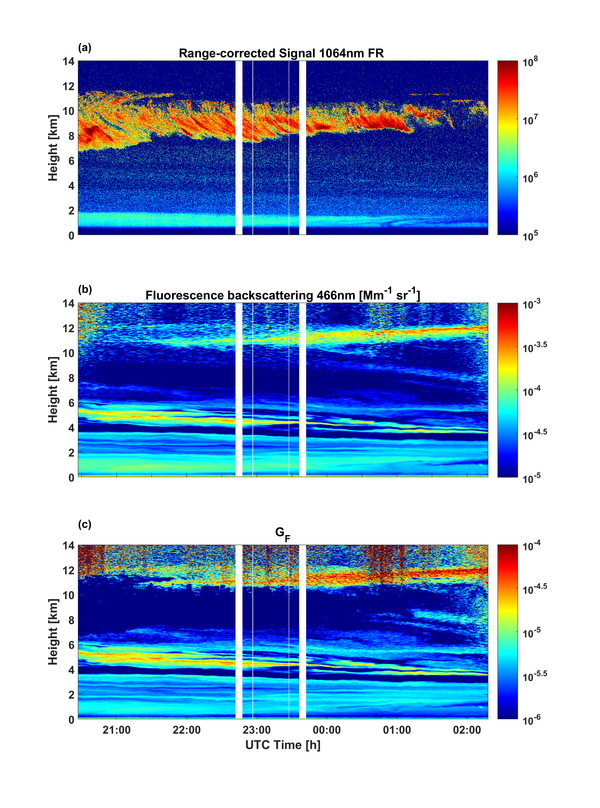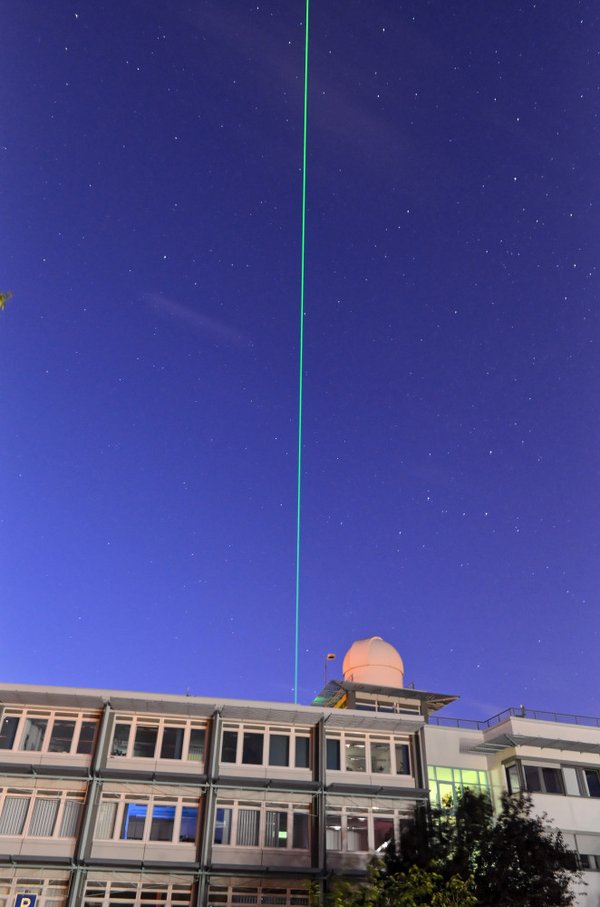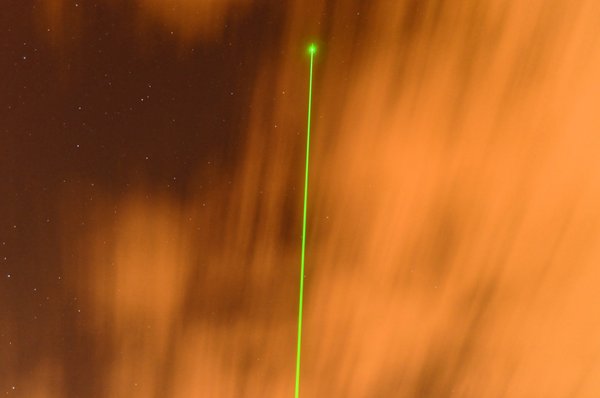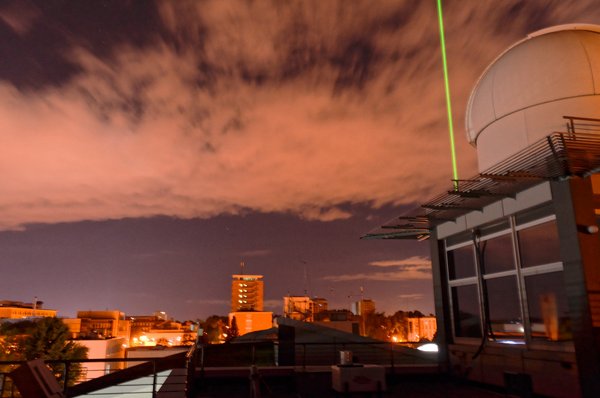Smoke from Canadian wildfires has been hanging over Germany for weeks.
Leipzig,
29.06.2023
New method improves detection of smoke particles in the atmosphere.
Leipzig. Huge wildfires in Canada have destroyed millions of hectares of forest, displaced more than 100,000 inhabitants and affected the air quality of millions of people in North America. The traces of this ecological disaster can also be felt in the atmosphere over Germany: since mid-May, researchers at the Leibniz Institute for Tropospheric Research (TROPOS) have been recording thin layers of smoke at altitudes between 3 and 12 kilometers above Leipzig. The proof that the particles are smoke from wildfires was made possible by a new technique: smoke particles are of biological origin and glow when illuminated with UV light from a laser. This allows them to be clearly distinguished from other particles such as volcanic particles or Sahara dust. The origin of the smoke layers could be traced back to North America using air currents.
"It is impressive and frightening at the same time to see the dimensions these wildfires have reached in the meantime: When forests burn for weeks in Canada and the USA, it is not only the people there who suffer from this disaster. The atmosphere over Europe is also affected: In the high, normally cloud-free air layers, thin veil clouds appear to form due to the smoke particles," reports Benedikt Gast from TROPOS, who is supervising and evaluating the current measurements as part of a doctoral thesis.
In contrast to North America, where in June the metropolises of the East Coast, among others, were covered in smoke for days and a fine dust alarm was issued, the smoke from North America certainly does not represent a health risk in Europe. The smoke layers at high altitudes and are now highly diluted. But it does affect the atmosphere and the climate: on the one hand, solar radiation is scattered by the particles and the light is thus slightly dimmed. Similar to Saharan dust, the sky can also look slightly cloudy. In addition, the smoke could influence cloud formation in higher layers of the atmosphere. At least that is what recent research suggests: during the MOSAiC expedition in the Arctic in 2020, TROPOS researchers were able to measure an unusually large amount of smoke in the atmosphere around the North Pole and observe the formation of cirrus clouds in those smoke environments. A recent study from Cyprus shows that smoke particles can act as nucleation nuclei for the formation of ice crystals under certain conditions. For this purpose, researchers from the Eratosthenes Centre of Excellence, the Cyprus University of Technology and TROPOS analysed data from Limassol in autumn 2020, when smoke from severe wildfires in North America was transported to the whole Mediterranean region from Portugal to Cyprus. The measurements at that time provided clear evidence that aged smoke particles at around -50°C triggered ice formation at the transition between the humid troposphere and the dry stratosphere, leading to the formation of ice clouds.
"Our current observations over Leipzig also show indications of such connection. During several measurements in the last few weeks, we were able to observe smoke layers, and ice clouds (also known as cirrus clouds) in its surroundings at altitudes from 10 to 12 km. Such smoke layers in the strong presence of cirrus clouds were observed not only in Leipzig but also in various stations in Europe: From the southwest in Evora (Portugal), through Warsaw (Poland) to Kuopio (Finland) in the northeast. The smoke causing more clouds, could open a new impact-pathway in the context of climate change, since clouds can have a cooling or warming effect, depending on their optical thickness, phase, and microphysical properties. The more intense and more frequent wildfires are potentially affecting atmospheric radiation budget at a still unknown extent. This potential motivates us to further investigate the interplay of forest-fire smoke and cloud formation," says Benedikt Gast from TROPOS.
Due to climate change, the number and intensity of wildfires are increasing, and with it the amounts of aerosol that are released into the atmosphere when biomass is burned. These aerosol particles can not only be distributed in the troposphere, but can even reach the stratosphere above and influence the Earth's radiation budget and cloud cover over long periods and large areas. "Since the start of the 2023 wildfire season in the northern hemisphere, we have seen smoke in almost every layer of the atmosphere, including the lower stratosphere. From an atmospheric science perspective, this is a worrying trend: global warming does not only seem to be causing the burn of large forests around the Arctic Circle, but those fires are more sever and frequent. It is also significantly changing our atmosphere and in turn influencing the climate. In addition, there is new evidence suggesting that the smoke is also disrupting the ozone layer and thus posing a health risk to millions of people," explains Dr Albert Ansmann from TROPOS.
In order to fully understand and quantify the effects of aerosols on climate, accurate aerosol typing is crucial. Multi-wavelength polarisation lidars, such as those operated by TROPOS at various locations, are very powerful tools in this respect for the detection and classification of aerosol with parameters such as the lidar ratio, the depolarisation ratio and the Ångström exponent. However, it has been difficult to distinguish stratospheric smoke from volcanic sulphate aerosol.
Recent studies have shown that fluorescence lidar has great potential to improve aerosol classification because it provides another parameter - the so-called fluorescence capacity (ratio of fluorescence backscatter to elastic backscatter coefficients). The researchers have therefore expanded their large, stationary atmospheric lidar at TROPOS in Leipzig: the "Multiwavelength Atmospheric Raman Lidar for Temperature, Humidity, and Aerosol Profiling" (MARTHA) received an additional receiving channel in August 2022 that can measure fluorescence backscatter in the spectral range of 444 - 488 nanometres. The experience gathered with the fluorescence observations at TROPOS, shows that it has great potential not only for aerosol typing, but also for finding smoke layers in the first place. "Since the new channel is only sensitive to particle scattering, it is perfectly suited for aerosol profiling. Several cases have proven this. A fluorescence channel in the lidar is like a having a loupe for aerosol layers," reports Dr. Cristofer Jimenez from TROPOS, "especially at low particle concentrations, the new approach could provide interesting and completely new results. There is much to explore and expect from the technique".
A more powerful laser, which can also be used to study even higher layers of the atmosphere and lower concentrations, is to follow in the next few months. Both the station in Leipzig and the one in Limassol belong to PollyNet, a network of lidar systems that use laser beams to study the atmosphere from the ground. It is part of the European research infrastructure ACTRIS, which studies aerosols, clouds and trace gases.
Publications:
Mamouri, R.-E., Ansmann, A., Ohneiser, K., Knopf, D. A., Nisantzi, A., Bühl, J., Engelmann, R., Skupin, A., Seifert, P., Baars, H., Ene, D., Wandinger, U., and Hadjimitsis, D.: Wildfire smoke triggers cirrus formation: Lidar observations over the Eastern Mediterranean (Cyprus), EGUsphere [preprint], https://doi.org/10.5194/egusphere-2023-988 , 2023.
The research was funded by the European Union (Horizon 2020, No. 385 857510 (EXCELSIOR), by the Government of the Republic of Cyprus, the European Union (Horizon 2020, No. 654109 and No. 739530 (ACTRIS)), the Federal Ministry of Education and Research (BMBF) (FKZ 01LK1603A (PoLiCyTa)), Norway & Cyprus (Prot. No.: LOCALDEV-0008 (ACCEPT)) and the Federal Ministry of Education and Research (BMBF) (FKZ 03F0915A (SCiAMO)).
Floutsi, A. A., Baars, H., Engelmann, R., Althausen, D., Ansmann, A., Bohlmann, S., Heese, B., Hofer, J., Kanitz, T., Haarig, M., Ohneiser, K., Radenz, M., Seifert, P., Skupin, A., Yin, Z., Abdullaev, S. F., Komppula, M., Filioglou, M., Giannakaki, E., Stachlewska, I. S., Janicka, L., Bortoli, D., Marinou, E., Amiridis, V., Gialitaki, A., Mamouri, R.-E., Barja, B., and Wandinger, U.: DeLiAn – a growing collection of depolarization ratio, lidar ratio and Ångström exponent for different aerosol types and mixtures from ground-based lidar observations, Atmos. Meas. Tech., 16, 2353–2379, https://doi.org/10.5194/amt-16-2353-2023 , 09 May 2023.
The research was funded by the European Union (FP7/ grant no. 262 254 (ACTRIS); Horizon 2020/ no. 654109 (ACTRIS-2); FP6/ no. 036 833-2 (EUCAARI); FP7/ no. 316210 (BEYOND), FP7/ no. 603445 (BACCHUS), Horizon 2020/ no. 857510 (EXCELSIOR)), the Federal Ministry of Education and Research (BMBF) (FKZ 01DK14014 (CADEX), PollyXT-CYP), the Leibniz Association (PAKT (OCEANET), the German Research Foundation (DFG) ("Megacities-Megachallenge - Informal Dynamics of Global Change" (SPP 1233), no. FOR 539 (SAMUN)), the Foundation of Science and Technology of Poland (FNiTP) (no. 519/FNITP/115/2010), the National Science Centre of Poland (NCN) (no. 2020/38/L/ST10/00480 (DAINA-2)), the European Research Council (grant no. 640458 (A-LIFE), no. 725698 (D-TECT)), the Federal Ministry for Economic Affairs and Energy (BMWi) (no. 50EE1721C (EVVA)), the National Fund for Scientific and Technological Development of Chile (FONDECYT) (no. 11181335), the Portuguese national funds through FCT (Fundação para a Ciência e Tecnologia, I. P.) (UIDB/04683/2020, UIDP/04683/2020), the Narodowe Centrum Nauki Poland (no. 2020/38/L/ST10/00480) and the Research Council of Lithuania (Lietuvos mokslo taryba) (no. S-LL-21-7).
Veselovskii, I., Hu, Q., Ansmann, A., Goloub, P., Podvin, T., and Korenskiy, M.: Fluorescence lidar observations of wildfire smoke inside cirrus: a contribution to smoke–cirrus interaction research, Atmos. Chem. Phys., 22, 5209–5221, doi.org/10.5194/acp-22-5209-2022, 2022.
The research was supported by the Agence Nationale de la Recherche (grant no. ANR-11-LABX-0005-01), the European Regional Development Fund (FEDER), the "Hauts de France" Regional Council (project CLIMIBIO) and the Russian Science Foundation (project 21-17-00114).
Contacts:
Benedikt Gast/ Dr. Cristofer Jimenez/ Dr. Albert Ansmann
TROPOS Department "Remote Sensing of Atmospheric Processes"
Phone +49-341-2717-7462, -7331, -7064
https://www.tropos.de/en/institute/about-us/employees/cristofer-jimenez
https://www.tropos.de/en/institute/about-us/employees/albert-ansmann
and
Prof. Dr. Andreas Macke
Director of TROPOS
Phone +49-341-2717-7060
https://www.tropos.de/en/institute/about-us/employees/andreas-macke
or
Tilo Arnhold, TROPOS public releations
Phone +49-341-2717-7189
https://www.tropos.de/en/current-issues/press-releases
Links:
recent news:
Smoke from the Canadian wildfires has been observed at 9km, and it descended until it reached a height of 6km over #Limassol. Clearly visible at @ERATOSTHENESCoE PollyXT observations on the 17th and 18th of June 2023.
https://twitter.com/excelsior2020eu/status/1670734738644926470?cxt=HHwWjICwrZKZ0q8uAAAA
Wildfire smoke in North America could be creating clouds over Europe (New Scientist, 16 Jun 23):
https://www.newscientist.com/article/2378628-wildfire-smoke-in-north-america-could-be-creating-clouds-over-europe/
Wildfire smoke travelling as far as Europe (BBC; 08 Jun 23): https://www.bbc.com/news/live/world-us-canada-65835239
Earlier press releases:
Smoke from the Black Summer wildfires in Australia influenced climate and high altitude winds in the southern hemisphere for over a year and a half (Press release, 06 Sep 2022):
https://www.tropos.de/en/current-issues/press-releases/details/rauch-der-black-summer-waldbraende-in-australien-beeinflusste-ueber-eineinhalb-jahre-klima-und-hoehenwinde-der-suedhalbkugel
Californian smoke drifted as far as Central Europe in autumn 2020 and caused heavy clouding of the sun (Press release, 01 Jun 2021):
https://www.tropos.de/en/current-issues/press-releases/details/kalifornischer-rauch-zog-im-herbst-2020-bis-nach-mitteleuropa-und-sorgte-fuer-starke-truebung-der-sonne
Smoke from US wildfires drifts over Germany (Newsflash, updated 14 Sep.2020):
https://www.tropos.de/en/current-issues/press-releases/kurzmitteilungen/rauch-von-us-waldbraenden-zieht-ueber-deutschland
Australian forest fires are felt as far away as Chile ( Newsflash, 06 Jan 2020):
https://www.tropos.de/en/current-issues/press-releases/kurzmitteilungen/rauch-aus-australien
Smoke from Canadian wildfires transported to Europe (Press release in German, 24 Aug 2017)
https://www.tropos.de/aktuelles/pressemitteilungen/details/rauch-von-kanadischen-waldbraenden-bis-nach-europa-transportiert
current data:
Lidar-Netzwerk PollyNet
https://polly.tropos.de/
NASA satellite data:
firms.modaps.eosdis.nasa.gov/map/
The Leibniz Institute for Tropospheric Research (TROPOS) is a member of the Leibniz Association, which connects 97 independent research institutions that range in focus from the natural, engineering and environmental sciences via economics, spatial and social sciences to the humanities. Leibniz Institutes address issues of social, economic and ecological relevance. They conduct knowledge-driven and applied basic research, maintain scientific infrastructure and provide research-based services.
The Leibniz Association identifies focus areas for knowledge transfer to policy-makers, academia, business and the public. Leibniz institutions collaborate intensively with universities – in the form of “Leibniz ScienceCampi” (thematic partnerships between university and non-university research institutes), for example – as well as with industry and other partners at home and abroad.
They are subject to an independent evaluation procedure that is unparalleled in its transparency. Due to the importance of the institutions for the country as a whole, they are funded jointly by the Federation and the Länder, employing some 20,500 individuals, including 11,500 researchers.
The entire budget of all the institutes is approximately 2 billion euros. They are financed jointly by the Federal Government and the Länder. The basic funding of the Leibniz Institute for Tropospheric Research (TROPOS) is therefore financed by the Federal Ministry of Education and Research (BMBF) and the Saxon State Ministry of Science and the Arts (SMWK). The Institute is co-financed with tax revenues on the basis of the budget approved by the Saxon State Parliament.
https://www.leibniz-gemeinschaft.de/en/home/
https://www.bmbf.de/en/index.html
https://www.smwk.sachsen.de/




